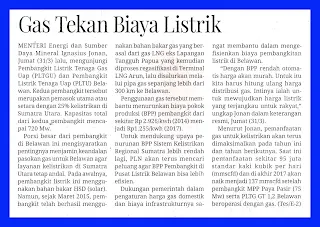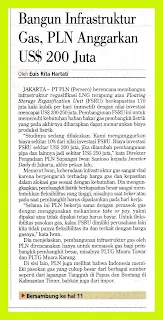Decree of the Minister of Energy and Mineral Resources Ignasius Jonan on divestment of 51 percent of PT Freeport Indonesia is very straightforward and resolute, even seem heroic. Jonan decision was not continuing involvement as provide space for Freeport to bargain for the amount of the composition of which is the requirement divested special mining business license (IUPK), such as the set of Government Regulation No. 1 of 2017. Jonan firmness to qualify IUPK who became one of the triggers CEO Mac Moran spread the threat to bring an action against Indonesia to international arbitration.
Unlike the decision on Freeport, Jonan it gives an opportunity for Total E & P Indonesie and Inpex Corporation to expand the right to manage in the Mahakam block, from 30 percent menjacli 39 percent. Not only that, Jonan offered two foreign contractors to remain the operator of the Mahakam block.
Whereas previous Minister's decision, Sudirman Said, already limit the portion of the management rights of the two contractors maximum 30 percent after the contract expires at the end of 2017. Initially, Sudirman Said will deliver 100 percent of the management rights to Pertamina as well as the sole operator of the Mahakam block.
However, Pertamina decided to bring back the existing operators to provide management rights for a maximum of 30 percent. The reason given by Jonan to enlarge the rights to manage and offer the right of the operator is to ensure no decrease in production volume currently managed by Pertamina.
The reason it implicitly indicates that Jonan Pertamina still doubt the ability to maintain production volume in operating the Mahakam block. Similar reasons never stated Minister of the SBY era, Jero Wacik.
Since 2008, Pertamina has repeatedly submitted proposals to the Ministry of Energy to manage the Mahakam block independently. Pertamina also expressed his readiness to allocate investment funds to optimize the production if later appointed as the sole operator of the Mahakam block. But then Minister Jero Wacik tend to prefer to extend the contract by Total E & P Indonesie and Inpex Corporation rather than cede the management of the Mahakam block to Pertamina.
Jero Wacik reasoned, Pertamina is not able to manage the Mahakam block, both in terms of the ability of human resources, technology, and financing investments. Doubt it shows that many mental state officials have colonized, which considers a foreign nation is superior to our own people still stick to the minds of the elite, even though Indonesia has more than 70 years of independence. Fortunately, the Minister Jero Wacik has been replaced Sudirman Said before she could decide the Mahakam block contract extension.
The ability of Pertamina in managing oil and gas fields offshore in fact is not in doubt. During this time, Pertamina has managed to increase production in the Offshore North West Java, which is the level of complexity is much higher than that Iebih Mahakam block.
Pertamina currently has more than 1,500 employees with an average experience of 20 years in oil and gas operations offshore. In addition, Pertamina still be able to hire former employees of Total E & P Indonesie, 95 percent of whom are Indonesian.
Pertamina also been wary of the potential decrease in production during the transition Mahakam block. To maintain gas production remained above 1 billion cubic feet (bcf), Pertamina will increase the number of drilling wells of six to 19 wells Pertamina even has set aside US $ 180 million or around Rp 2.34 trillion to fund the drilling of 19 wells. Indeed, At the beginning of the takeover by Pertamina, production is likely to decline. However, the operation of 19 wells, gas production will increase, which is expected to reach 1.6 bcf in the next year.
Mahakam block the transfer of management of Total E & P Indonesie to Pertamina would be a good precedent for the country. Pertamina will be more confident in every oil and gas land acquisitions of foreign contractors.
This will enhance the ability of Pertamina in managing the accumulation of oil and gas fields, which will be very useful when Pertamina operate oil and gas fields abroad. By doing so, Pertamina could become a formidable enterprise global class.
Thus, there is no reason to doubt the ability of the Minister of Jonan for Pertamina to maintain production volume after the takeover of the Mahakam block. Jonan should remain consistent in decision-making between Freeport and the Mahakam block. Do not even open up opportunities for Total E & P Indonesie and Inpex Corporation to expand the right to manage and maintain themselves as the operator of the Mahakam block after expiration of the contract at the end of 2017.
IN INDONESIAN
Lain Freeport, Lain Mahakam
Keputusan Menteri Energi dan Sumber Daya Mineral Ignasius Jonan tentang divestasi 51 persen saham PT Freeport Indonesia sangat lugas dan tegas, bahkan terkesan heroik. Keputusan Jonan itu seolah tidak Iagi memberikan ruang bagi Freeport untuk menawar besaran komposisi divestasi sahamnya yang menjadi syarat izin usaha pertambangan khusus (IUPK), seperti di atur Peraturan Pemerintah Nomor 1 Tahun 2017 . Ketegasan Jonan untuk memenuhi syarat IUPK itu yang menjadi salah satu pemicu CEO Mac Moran menebar ancaman untuk memperkarakan Indonesia ke arbitrase internasional.
Berbeda dengan keputusan soal Freeport, Jonan justru memberikan peluang bagi Total E&P Indonesie dan Inpex Corporation untuk memperbesar hak kelola di Blok Mahakam, dari 30 persen menjacli 39 persen. Tidak hanya itu, Jonan menawari dua kontraktor asing tersebut untuk tetap menjadi operator Blok Mahakam.
Padahal keputusan Menteri ESDM sebelumnya, Sudirman Said, sudah membatasi porsi hak kelola dua kontraktor tersebut maksimal 30 persen setelah masa kontrak berakhir pada akhir 2017. Awalnya, Sudirman Said akan menyerahkan 100 persen hak kelola kepada Pertamina sekaligus sebagai operator tunggal Blok Mahakam.
Namun Pertamina memutuskan untuk mengajak kembali operator yang ada dengan memberikan hak kelola maksimal 30 persen. Alasan yang dikemukakan Jonan untuk memperbesar hak kelola dan menawarkan hak operator adalah menjamin tidak terjadinya penurunan volume produksi saat dikelola Pertamina.
Alasan itu secara tersirat menunjukkan bahwa Jonan masih meragukan kemampuan Pertamina untuk mempertahankan volume produksi dalam mengoperasikan Blok Mahakam. Alasan serupa juga pernah dikemukakan Menteri ESDM era pemerintahan SBY, Jero Wacik.
Sejak 2008, Pertamina telah berulang kali mengajukan usul kepada Kementerian ESDM untuk mengelola Blok Mahakam secara mandiri. Pertamina juga menyatakan kesanggupannya mengalokasikan dana investasi untuk mengoptimalkan produksi jika kelak ditunjuk sebagai operator tunggal Blok Mahakam. Namun saat itu Menteri Jero Wacik cenderung lebih memilih memperpanjang kontrak Total E&P Indonesie dan Inpex Corporation daripada menyerahkan pengelolaan Blok Mahakam kepada Pertamina.
Jero Wacik beralasan, Pertamina tidak mampu mengelola Blok Mahakam, baik dari sisi kemampuan sumber daya manusia, teknologi, maupun pendanaan investasi. Keraguan itu menunjukkan bahwa banyak pejabat tinggi negara mempunyai mental terjajah, yang menganggap bangsa asing lebih unggul daripada bangsa sendiri masih menempel dipikiran para elite, meski Indonesia sudah merdeka lebih dari 70 tahun. Untungnya, Menteri Jero Wacik sudah digantikan Sudirman Said sebelum sempat memutuskan perpanjangan kontrak Blok Mahakam.
Kemampuan Pertamina dalam mengelola lapangan minyak dan gas di lepas pantai sebenarnya sudah tidak diragukan lagi. Selama ini Pertamina telah berhasil meningkatkan produksi di Blok Offshore North West Java, yang tingkat kompleksitasnya jauh Iebih tinggi daripada Blok Mahakam.
Pertamina saat ini memiliki lebih dari 1.500 karyawan dengan pengalaman rata-rata 20 tahun di operasi minyak dan gas lepas pantai. Selain itu, Pertamina masih dapat mempekerjakan mantan karyawan Total E&P Indonesie, yang 95 persennya merupakan warga negara Indonesia.
Pertamina juga sudah mewaspadai potensi penurunan produksi Blok Mahakam selama masa transisi. Untuk menjaga produksi gas tetap di atas 1 miliar kaki kubik (bcf), Pertamina akan meningkatkan jumlah sumur pengeboran dari enam menjadi 19 sumur Pertamina bahkan telah menyiapkan dana US$ 180 juta atau sekitar Rp 2,34 triliun untuk membiayai pengeboran 19 sumur itu. Memang, Pada awal pengambilalihan oleh Pertamina, produksi berpotensi menurun. Namun, dengan dioperasikannya 19 sumur itu, produksi gas akan kembali meningkat, yang diperkirakan bisa mencapai 1,6 bcf pada tahun berikutnya.
Pengalihan pengelolaan Blok Mahakam dari Total E&P Indonesie ke Pertamina akan menjadi preseden baik bagi negeri ini. Pertamina akan semakin percaya diri dalam setiap pengambilalihan lahan minyak dan gas dari kontraktor asing.
Ini akan meningkatkan akumulasi kemampuan Pertamina dalam mengelola lahan minyak dan gas, yang akan sangat berguna saat Pertamina mengoperasikan lahan minyak dan gas di luar negeri. Dengan begitu, Pertamina dapat menjadi perusahaan tangguh kelas global.
Maka, tidak ada alasan bagi Menteri Jonan untuk meragukan kemampuan Pertamina dalam mempertahankan volume produksi setelah pengambilalihan Blok Mahakam. Jonan semestinya tetap konsisten dalam pengambilan keputusan antara Freeport dan Blok Mahakam. Jangan malah membuka peluang bagi Total E&P Indonesie dan Inpex Corporation untuk memperbesar hak kelola dan tetap mempertahankan diri sebagai operator Blok Mahakam setelah berakhirnya kontrak pada akhir 2017.
Koran Tempo, Page-11, Monday, Apr, 3, 2017










